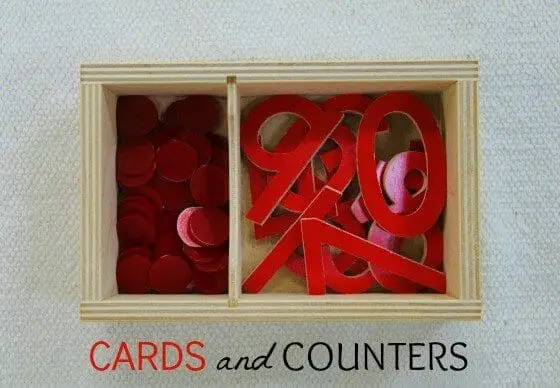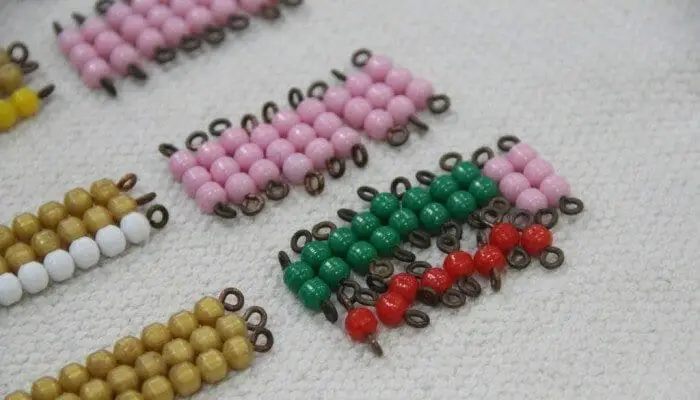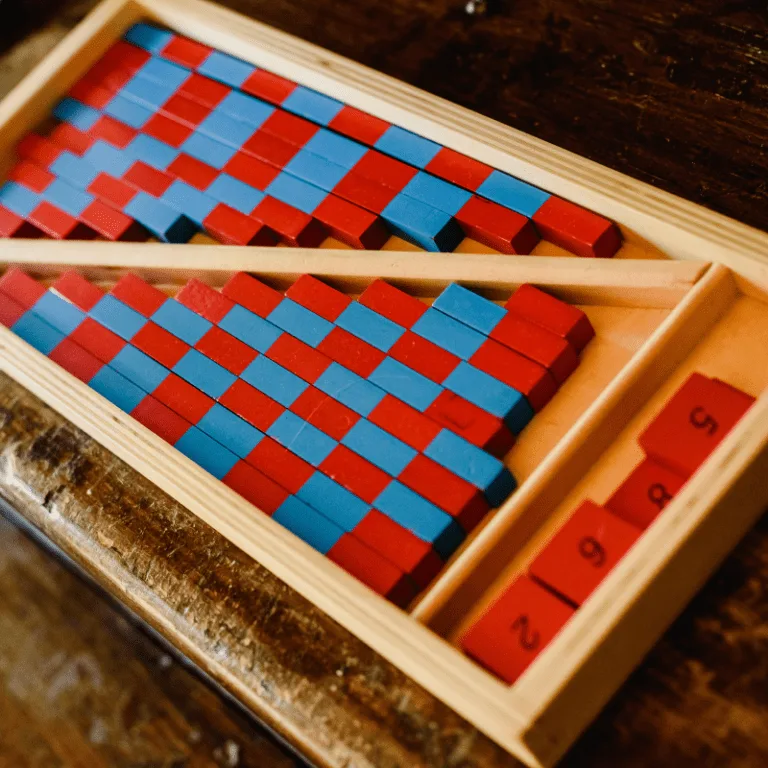SHARE THIS POST:
Montessori Math is a beautiful thing. The whole approach to Montessori math and Montessori math extensions inspires me every day. I think, yes, this is how child are supposed to learn math. Check out my post on the philosophy behind Montessori math for more.
Montessori Math Extensions & Variations
Number Rods
- Count around the triangle formed by the stair
- Fetch game
- Greater than/less than
- Challenge child to find two rods that match the length of a third rod
Sandpaper Numerals
- Play Memory
- “What’s missing?”
- “Knock, Knock”
- Secret message games like tracing a number on a child’s back or palm & having the child guess which number
- Play “Go fish”
Number Rods & Numerals
- Fetch game
- Randomly array rods on mat. Ask the child to find the longest rod. Count the segments. Find the numeral that goes with it.
- Ask the child to find the next longest rod and the numeral that goes with it. Ask the child which rod could we place with the 9 rod to give us 10. And so on.
- Mystery number with two children. One child gets secret numeral, counts objects to match the numeral. The other child counts the objects and finds the rod to match the secret numeral.
- See examples above from Number Rods lesson
Spindle Box
- Use other objects in place of the spindles
- Play “What’s Missing?”
- Play “What’s Wrong with this Picture?”

Cards & Counters
- Use other objects in place of the red counters (like the acorn example above)
- Lay counters out in a different pattern under the numerals
- Work with larger quantities
- Child makes on set of cards and counters
- Work with larger quantities & identify odd and even number
Golden Beads Presentation Tray
- Play What’s Missing? game
- Mystery Bag with items on the tray
- Mix up items from tray and have the child put them in order
- Make own beads
- Draw beads in Presentation Tray
- Color photocopy of sketch of tray
- Nomenclature cards of materials
Equivalence & Crisis of Nine Tray
- Use separate mats for each quantity so the child must move his body considerably to count the beads
- Ask the child to give you or to bring to you various quantities. Occasionally ask for ten of something to check if the child understands the exchange.
- Make a Take Home Booklet showing equivalence. So, ten units on one page and a ten bar on the opposite facing page. etc
- Draw or color the bead material
Overview of the Golden Beads
- Question the child about the place values as he admires the finish work
- Ask the child to point out various quantities on the mat
- Have the child “teach” another child from the classroom
- Child can place quantities “randomly” or two at a time rather than all the units at once
- Draw or color a sketch of the layout
- Child can recreate using other objects
Overview of Numerals
- Child can construct this horizontally.
- Can remove symbols and have child guess “what’s missing”.
- Can ask the child to turn away, while you move cards out of sequence. find the mixed up cards and fix them.
- Child can record this on graph paper or make her own set of cards.
Composition of Symbols
- Child partners with another child to play fetch
Bird’s Eye View
- Remove or mix numerals or quantities. Child has to guess what is missing or reorder the mixed items.
- Invite the child to give a tour of the places and values in the decimal system to any child who comes to look at his work.
- Guide the child who is getting the demonstration to ask for directions to the 5 thousand symbol, the 600 quantity, etc.
- Child can sketch his work.
- Write a story about his bird’s eye view of the decimal system.
Composition of Numerals and Quantities
- Use boxes of prepared slips mentioned under formation of symbols and let an older child take the teacher’s role. He or she can be doing math work too by “recording” turns on a chart or graph if introduced to its use.
- One child can set up a quantity of beads, her friend has to form the appropriate symbol. Or she can form symbol, and friend must form quantity. Another child can record the outcome of this work on a chart too.
Bank Game
- Child can count random quantities or the whole bank.
- Count stamps in the stamp game after having an introduction.
- Can do this with pennies, nickels, dimes, quarters and dollars to teach equivalence of coins.
Golden Bead Operations
- Gradually withdraw from giving child numerals and let him read numerals in a prepared booklet or copy them from a card. At this point direct the child to begin his work by preparing his own small bank which he keeps on a tray on his mat. This reduces trips to the shelf which confuse and frustrate many children during calculation work. If working on static problems, the child needs nine of each quantity in his bank. If working on dynamic problems he needs eighteen units, tens, and hundreds and nine thousands in his bank.
- When the child can work from a booklet, he is probably ready to do these problems individually.
- If writing is a problem, stamps can be used to record the answers.
- Child can make up his own equations after having learned procedures for dynamic.
Stamp Game
- Variations are offered in the equation sequence and in the ways of offering the equations.
More Montessori Math Extensions
Dot Game
- The child could record the dots in the colors that correspond to each category (green, blue, red,).
- Children will sometimes choose to record something other than dots in each box.
Number Rod Addition
- You can give the child prepared equation booklets with equations ordered (each page contains the same addend added to all other possible units. 1+1, 1+2, 1+3 etc. The equations may be ordered or random.)P
- Prepare baskets of equation slips which the child selects and does randomly.

Short Bead Stair Addition
- Equation booklets with pages in order or random, or blank booklets for the child to fill with his own equations.
- Blank booklets for child to make up his own equations.
- Printed outlines of the bead bars for the child to color, cut out, label, into equations.
Addition Strip Board
- Child can find all the combinations that make a certain number and cross old the duplicates. This is the commutative law of addition.
- Give the child a booklet of equations out of order or in order, or random equations in a basket.
Subtraction Strip Board
- Booklet with equations 1 – 1, 2 – 2, 3 – 3, 4 – 4, to 10 – 10 on one page; 2 – 1, 3 – 2, 4 – 3 to 10 – 9 on next page; 3 – 1, 4 – 2, 5 – 3 on next page; etc. All answers on a page are the same.
- Booklet of 2 – 0, 2 – 1, 2 – 2 on one page; 3 – 0, 3 – 1, 3 – 2, 3 – 3 on the next page; etc. up through 9. Another booklet which follows same pattern from 10 – 18.
- Random equations in a basket.
- Make up his own equations.
- Child can be given loose counters to do these booklets. She forms the quantity, takes away the subtrahend, and records the difference.
Short Bead Stair Multiplication
- Build the entire Table of Pythagoras. Put out each number times itself to notice what is formed.
- Build the plastic decanomial.
- Do the same equations with a pegboard.
- Draw these equations on graph paper.
Multiplication Board
- Random equations in booklet form.
- Random equations from a basket.
Division Board
- Random equations on slips in a basket.
- Choosing a number between 1 and 81 to divide, and trying all possible divisors.
Composition of Quantities
- Child can retrieve quantities from the bank
- Children can work together to request quantities and record those quantities
Introduction to Numerals
- “What is missing?” game
- Turn cards over. Ask the child to identify the numerals from the size of the card.
- Place cards randomly. Ask the child to order first by looking, then by touching only.
- Child makes own set of cards
- Colors in numerals
- Child creates own version of presentation tray


